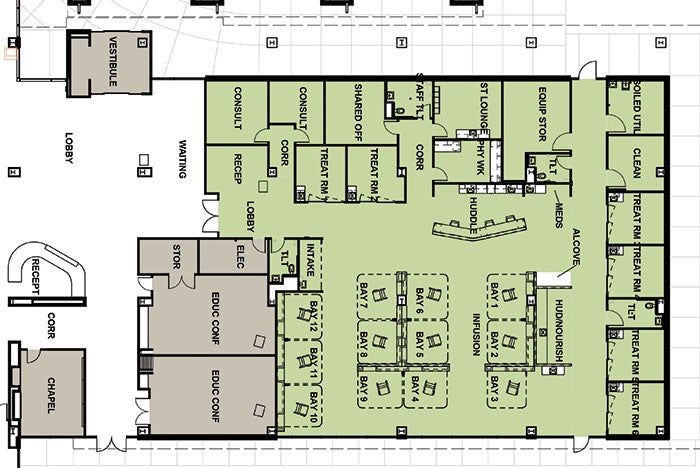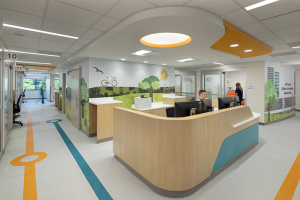Design guidelines for short-stay patient units
Clinical practice and improved operations are substantially reducing inpatient lengths of stay while increasing services provided in an outpatient setting.
Driven by the CMS two-midnight rule and other financial incentives, hospitals are classifying more stays as outpatient observation. For instance, Medicare beneficiaries increasingly are designated as observation patients in hospitals; the number rose 88 percent between 2006 and 2012, according to a 2012 report by the Medicare Payment Advisory Commission.
To handle these occupancies, hospitals have been building a new generation of short-stay spaces within their facilities.
Patients and settings
Who are these short-stay/observation-status patients and why are they staying overnight in the hospital? Some of these patients include:
- Postsurgical, procedural and diagnostic recovery patients who usually need less than 12 hours to recover before they are sent home, but may stay longer or overnight if their home environments are not conducive to their recovery or their procedure is late in the day.
- Patients who require brief hospitalization and can be discharged as soon as clinical conditions are resolved.
- Patients who present to the emergency department (ED) and then require a period of treatment or monitoring in order to make a decision concerning their admission or discharge.
These patients may need clinical services similar to a medical-surgical inpatient and may sleep overnight at the hospital. The goal is to send the patient home as soon as medically appropriate.
Several different settings within the hospital that can house short-stay patients include observation units (OUs), post-procedural areas and universal care units (UCUs).
Dedicated OUs have been shown to be equal to or better in quality and lower in cost than inpatient care for certain conditions, especially when specific protocols are in place, according to an article in the October 2012 edition of Health Affairs. Moreover, a piece in the February 2014 edition of the International Journal of Emergency Medicine showed that 4 to 10 percent of annual ED visits usually can be accommodated in a clinical decision unit (CDU) or OU.
Responsibility for this type of patient remains an issue — different physicians (i.e., emergency physician, hospitalist or specialist) may assume their care depending on the unit.
Post-procedural, short-stay patients typically remain in associated Level 2 recovery areas adjacent to their point of procedure, which may be surgery, endoscopy or interventional. Typically, these units stay open until early evening. Unless these units are operated 24/7, patients are then moved to inpatient units if they have not been discharged. However, the reimbursement is much lower for these patients than for inpatients and the hospital can lose revenue if staffing and services are the same.
You may also like |
| 2017 Hospital Construction Survey |
| The importance of flexible health care facilities |
| Efficient emergency department designs |
| Devising flexible interior spaces |
|
As observation-status volume has increased, hospitals have looked at new ways to effectively house these patients. Aggregating observation-status patients into a UCU near its feeder departments — emergency, surgical/interventional and imaging — allows the beds to flex from daytime patient volume driven by procedures to an ED observation stay overnight, providing a high utilization of patient rooms 24/7.
However, peak census driving adequate bed count is often hard to determine due to variability in each department. A successful UCU operates like an inpatient bed unit requiring its own clinical administration and electronic records/bed board that can be accessed by multiple departments. The UCU works best in a community hospital setting where the short-stay patient volume can be accommodated in one location.
At Kettering Indu & Raj Soin Medical Center in Beavercreek, Ohio, the 20-bed UCU is central to multiple feeder departments (i.e., ED, surgery, imaging, gastroenterology), but has no exterior views or windows. A skylit interior garden provides respite for waiting families just outside the unit.
Larger or tertiary hospitals may aggregate observation-status/short-stay patients by service line or by providing separate short-stay units near procedural recovery. For instance, a major cardiovascular center may have its own short-stay CDU on an inpatient floor. Some academic centers have created patient rooms without windows inboard on inpatient units to accommodate less than 23-hour stays, cohorted with inpatient beds of the same service line.
Short-stay codes
Health care guidelines and building codes are beginning to address the issues of a short-stay patient, but there is still ambiguity.
The Facility Guidelines Institute's (FGI's) 2014 Guidelines for Design and Construction of Hospitals and Outpatient Facilities defines the observation unit “for patients requiring observation up to 24 hours” but not addressing that a 23-hour stay is usually overnight or that observation status could encompass two midnights. There is no requirement for windows or natural light. The nursing unit section dictates that patient rooms “shall be provided with natural light by means of a window to the outside” but does not address length of stay or mention short-stay or observation status.
The Centers for Medicare & Medicaid Services (CMS) adopted the 2012 edition of NFPA 101, Life Safety Code, effective November 2016, reducing conflicts with other current building codes. This includes most of the 2012 NFPA 99, Health Care Facilities Code, sections.
One important CMS addition is where patient room windows are required. Buildings constructed after the effective rule date must have an outside window or outside door in every sleeping room and the sill height must not be higher than 36 inches above the floor. Exceptions include newborn nurseries and rooms intended for occupancy for less than 24 hours. Windows into atrium spaces are allowable.
While a short-stay patient who stays in a room for even 23 hours almost always requires an overnight stay, essentially making it a sleeping room, no one is sure yet how this ruling will be enforced, affecting the design of new short-stay units. Many observational, clinical decision or universal care units in design or under construction, are embedded within the hospital, without windows, to allow for proximity to adjacent feeder departments such as emergency, surgery and special procedures and, therefore, noncompliant with the new code interpretation.
There is no shortage of compelling research on how natural light affects outcomes in hospitals, including reducing length of stay, improving sleep, easing pain and improving the work environment. A sill height at 36 inches means that outward views are also important. Yet, it’s costly to increase building perimeter or provide atria to allow for natural light into short-stay patient rooms, especially in this age of decreased reimbursement for outpatient hospital stays.
Design recommendations
Typically, hospital-based OUs mimic ED layouts, placing the highest priority on visibility from clinical workstations. Patient spaces are either open bays or rooms with full-front glass sliding doors, like an ED treatment bay. A typical patient room size is 120 to 140 square feet, allowing a 4-foot clearance on each side of a bed.
At minimum, these rooms have a hand-washing sink, clean supply storage and either a wall-hung or mobile computer for charting. The headwall includes medical gas outlets for oxygen and vacuum, electrical power outlets and nurse call. Lighting encompasses ambient room and exam lighting and a patient reading fixture. Televisions are usually provided. Most bays or rooms have one or two seats for family. Wall protection to 4 feet above the floor is important because bed movement can damage the headwalls. The FGI guidelines recommend one toilet per six patients minimum.
Though outpatient status, nurse staffing can be more like an inpatient unit, with a 1-to-5 nurse-to-patient ratio. A grouping of 10 rooms to a clinical workstation supports this ratio. The stay is short, but the level of service required can be intense and the facility needs to support clinical operations with nourishment stations, medication and clean storage rooms, soiled material holding and alcoves for crash carts, beds, wheelchairs and other movable equipment. The unit size must be manageable and have clear wayfinding. Units typically can range in size from 10 to 40 beds depending on the philosophy of care. A discharge lounge with recliners also may be appropriate to transition patients home.
As outpatient observation duration has lengthened, the requirements for patient support and family accommodations have increased. Longer observation stays dictate the patient’s need for more privacy, access to toilets and noise and light control that are important for sleep.
Closed rooms with doors rather than open bays or glass sliding walls should be considered where direct viewing of patients is not as important. This type of patient should have direct access to a toilet, but could use a separate showering facility if needed before going home. Building full-size, acuity-adaptable inpatient rooms, though flexible, is not cost effective, considering reduced reimbursement for short-stay outpatients.
Patients staying 12 hours or less or those patients not staying overnight, don’t necessarily need a window. Sleeping rooms for less than 24-hour stays could have borrowed lights or simulated windows that represent day/night lighting conditions. Allowing immediate proximity to windows in a suite or an adjacent corridor could provide relief as patients begin to walk.
For instance, the new UCU at Advocate Good Shepherd Hospital in Barrington, Ill., utilizes large skylights to infuse natural light in the patient room corridors. Waking up without any orientation to natural light and views to the outdoors is disheartening and not conducive to healing. Wherever possible, longer-stay observation patient rooms should have a window.
Many hospitals have repurposed existing obsolete med-surg units to become short-stay units. They may have patient rooms that are too small by current inpatient standards, but can accommodate short-stay patients quite well. These private rooms have windows, their own toilets and sometimes showers. The main issue is the proximity of a patient unit to the areas generating patients (i.e., ED and surgery). Many low-acuity community hospitals operate surgery inpatient units on an observation-status model because stays are short and prescriptive.
Family accommodations are important, especially if the patient rooms themselves are of minimal size.
Family waiting areas should include comfortable seating with multiple levels of privacy and consult areas for meetings with providers. Computer docking stations and desks allow families to work while waiting for patients. A coffee bar or other easy access to food service is important. If possible, views to the outdoors and natural light can relieve stress.
Bridging the gap between inpatient care and off-site clinics, health systems also are experimenting with cost-effective, short-stay settings outside of the hospital. The microhospital concept pairs a freestanding ED with short-stay beds for patient convenience, reducing transfers to larger-scale hospitals.
Emerus is the first and largest developer of microhospitals — fully licensed hospitals, averaging between 15,000 to 50,000 square feet, that provide approximately eight short-stay, observation/inpatient beds to support a freestanding ED.
These hospitals typically are located in suburban or rural areas that are underserved by community hospitals in their area. Each microhospital has pharmacy, laboratory and imaging services. Some also offer ancillary services that may include primary care, dietary services, labor and delivery, pediatric care and/or outpatient surgery.
Although only 8 to 10 percent of their emergency visits require further hospitalization, with 75 percent of these patients transferred to associated full-service hospitals, the short-stay beds at these facilities serve an important function. Patients can be stabilized or recover from medical conditions for an average of two days close to their homes, and roughly 50 to 60 percent of these short-stay patients are classified as outpatient observation.
Intensive outpatient care programs treat and stabilize “frequent-flyer” patients with multiple chronic conditions. Otherwise, these sometimes frail, mostly elderly patients would frequent the ED or be readmitted. They benefit clinically from both programs and places that improve access and create a better patient experience, usually co-located near a hospital. This affords health care designers an opportunity to develop a new, potentially unique, health care setting.
Meeting the needs
The definition of outpatient observation status is likely to morph and change as lawmakers and insurance companies adjust to new clinical practices and subsequent reduced reimbursement.
The rapid increase in short-stay patients will continue, unless readmission rates rise to an unacceptable level and length
of stay again increases. Health care facility planners will strive to house patients in the lowest-cost setting, whether on or off campus.
As codes adjust to this new practice pattern, health care facility designers and managers must make sure that the environment of care meets the needs of patients, family and staff, rather than just meeting current minimal codes.
Sheila F. Cahnman, FAIA, FACHA, LEED AP, is president of JumpGarden Consulting LLC, Wilmette, Ill. She can be reached at sheila@jumpgardenllc.com.
 This feature is one of a series of articles published by Health Facilities Management in partnership with the American College of Healthcare Architects.
This feature is one of a series of articles published by Health Facilities Management in partnership with the American College of Healthcare Architects.






